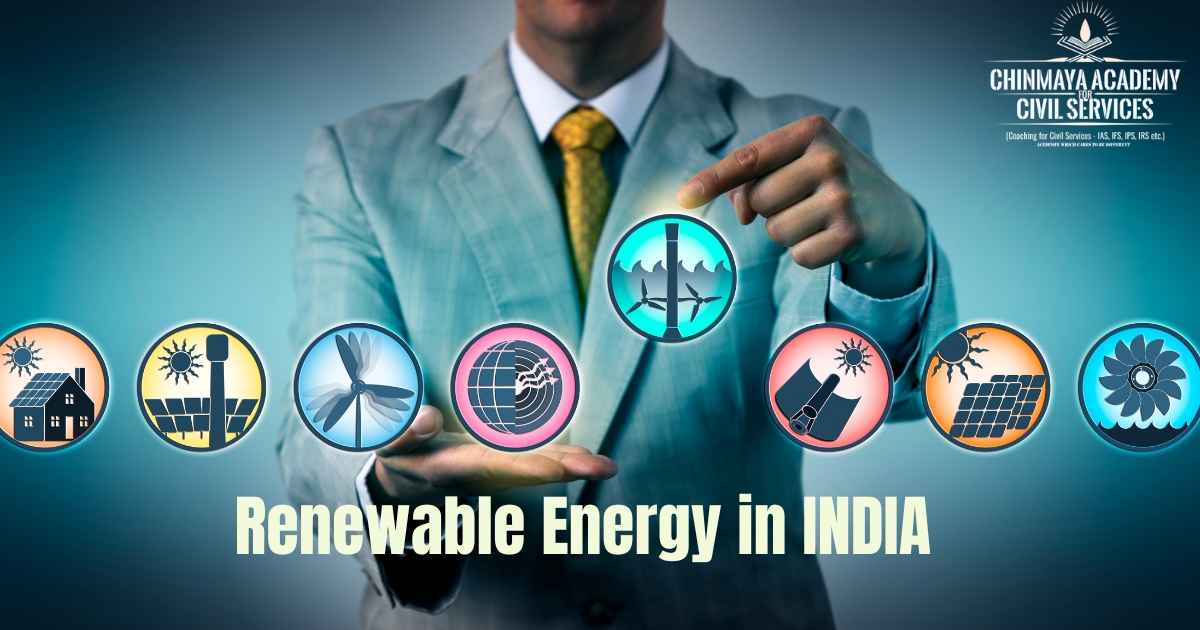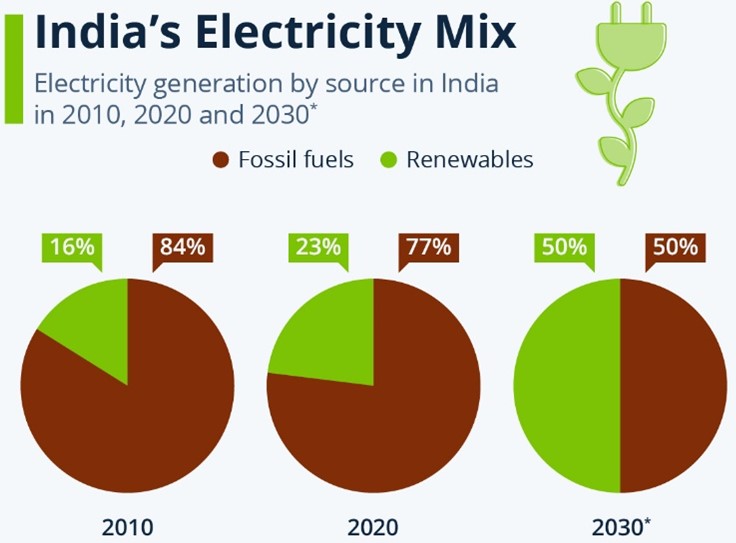
India is the world’s third-largest consumer of electricity and the third-largest producer of renewable energy. As of July 2023, renewable energy sources have a combined installed capacity of 179.322 GW, which accounts for 43% of India’s total energy capacity.
Renewable energy in India

Solar power is the largest source of renewable energy in India, with an installed capacity of 67.07 GW. Wind power is the second-largest source, with an installed capacity of 42.8 GW. Other renewable energy sources include biomass, small hydropower, and waste to energy.
- India sets sight on 40 GW renewable energy capacity by 2024
- India targets to produce 50% as renewable energy by 2030
- Solar energy: India is targeting to achieve 280 GW of solar power capacity by 2030.
- Wind energy: India is targeting to achieve 300 GW of wind power capacity by 2030.
Solar power plant in India
India has set an ambitious target to achieve 500 GW of renewable energy capacity by 2030. This target is part of India’s Panchamrit commitments at the COP26 climate summit.
The Indian government is supporting the growth of renewable energy through a number of initiatives
- Financial incentives
- Land acquisition
- Infrastructure development
The growth of renewable energy in India is having a number of positive benefits
- Reducing India’s reliance on imported fossil fuels: India currently imports over 80% of its oil and gas needs. The growth of renewable energy will help to reduce India’s reliance on imported fossil fuels and improve its energy security.
- Reducing India’s greenhouse gas emissions: Renewable energy sources such as solar and wind power do not produce greenhouse gas emissions. The growth of renewable energy will help to reduce India’s greenhouse gas emissions and help to combat climate change.
- Creating jobs and boosting the Indian economy: The renewable energy sector is creating jobs and boosting the Indian economy. The government estimates that the renewable energy sector will create over 10 million jobs by 2030.

India is a global leader in the growth of renewable energy. The country’s ambitious targets and supportive policies are helping to make India a cleaner and more sustainable energy future. India has a separate Ministry of New and Renewable Energy (MNRE).
The Indian government has launched a number of schemes to promote renewable energy in the country.
Some of the key schemes include:
- National Solar Mission (NSM): The NSM was launched in 2010 with the aim of achieving 100 GW of solar power capacity by 2022. The mission has since been revised to achieve 280 GW of solar power capacity by 2030. The NSM provides financial incentives such as subsidies and tax breaks for the development and installation of solar power projects.
- National Wind Power Mission (NWPM): The NWPM was launched in 2015 with the aim of achieving 60 GW of wind power capacity by 2022. The mission has since been revised to achieve 300 GW of wind power capacity by 2030. The NWPM provides financial incentives such as subsidies and tax breaks for the development and installation of wind power projects.
- Pradhan Mantri Kisan Urja Suraksha evam Utthaan Mahabhiyan (PM KUSUM) Scheme: The PM KUSUM scheme was launched in 2019 with the aim of providing financial assistance to farmers for the installation of solar pumps and rooftop solar panels. The scheme also aims to reduce agricultural power consumption and increase farmers’ income.
- Production Linked Incentive (PLI) Scheme for Manufacturing of High Efficiency Solar PV Modules: The PLI scheme for solar PV modules was launched in 2021 with the aim of boosting the domestic manufacturing of solar PV modules. The scheme provides financial incentives to manufacturers of high efficiency solar PV modules.
- National Green Hydrogen Mission: The National Green Hydrogen Mission was launched in 2021 with the aim of developing a green hydrogen economy in India. The mission aims to reduce the cost of green hydrogen production and make it competitive with fossil fuels.
In addition to these schemes, the government also provides a number of other incentives for the development and installation of renewable energy projects, such as:
- Net Metering: Net metering allows consumers to generate their own electricity from renewable energy sources and sell the excess electricity back to the grid.
- Green Energy Certificates (RECs): RECs are tradable certificates that represent the environmental benefits of generating electricity from renewable energy sources.
- Accelerated Depreciation: Renewable energy projects are eligible for accelerated depreciation, which allows businesses to claim higher depreciation allowances in the early years of the project.
The government also provides a number of support mechanisms for the renewable energy sector, such as:
- Renewable Energy Development Agency (IREDA): IREDA is a public sector financial institution that provides loans and other financial assistance for renewable energy projects.
- Solar Energy Corporation of India (SECI): SECI is a public sector company that promotes and develops solar energy projects.
- National Institute of Solar Energy (NISE): NISE is a research and development institute that works on solar energy technologies.
The Ministry of New and Renewable Energy (MNRE)

It is the nodal Ministry of the Government of India for all matters relating to new and renewable energy. The broad aim of the Ministry is to develop and deploy new and renewable energy to supplement the energy requirements of the country.
The role of new and renewable energy has been assuming increasing significance in recent times with the growing concern for the country’s energy security. Energy self-sufficiency was identified as the major driver for new and renewable energy in the country in the wake of the two oil shocks of the 1970s.
Vision
To develop new and renewable energy technologies, processes, materials, components, sub-systems, products & services at par with international specifications, standards and performance parameters in order to make the country a net foreign exchange earner in the sector and deploy such indigenously developed and/or manufactured products and services in furtherance of the national goal of energy security.
Mission
- Energy Security
- Increase in the share of clean power
- Energy Availability and Access
- Energy Affordability
- Energy Equity
Other NEWS
| The river Phalgu to Gaya and Bodh Gaya | If Gaya is all about Hinduism with its legend of Ram and Sita and the world famous Vishnupad Mandir, Bodh Gaya, about 15 km away, is the centre of Buddhism with its famous Mahabodhi temple, and the Bodhi tree under which the Buddha attained enlightenment |
| The International Solar Alliance (ISA) | A gathering of 116 member countries formed to accelerate the global adoption of solar technology
The first-time compile and release a ‘global solar stocktake report’ |
| An ancient landscape |
|
 Chinmaya IAS Academy – Current Affairs Chinmaya IAS Academy – Current Affairs
Chinmaya IAS Academy – Current Affairs Chinmaya IAS Academy – Current Affairs